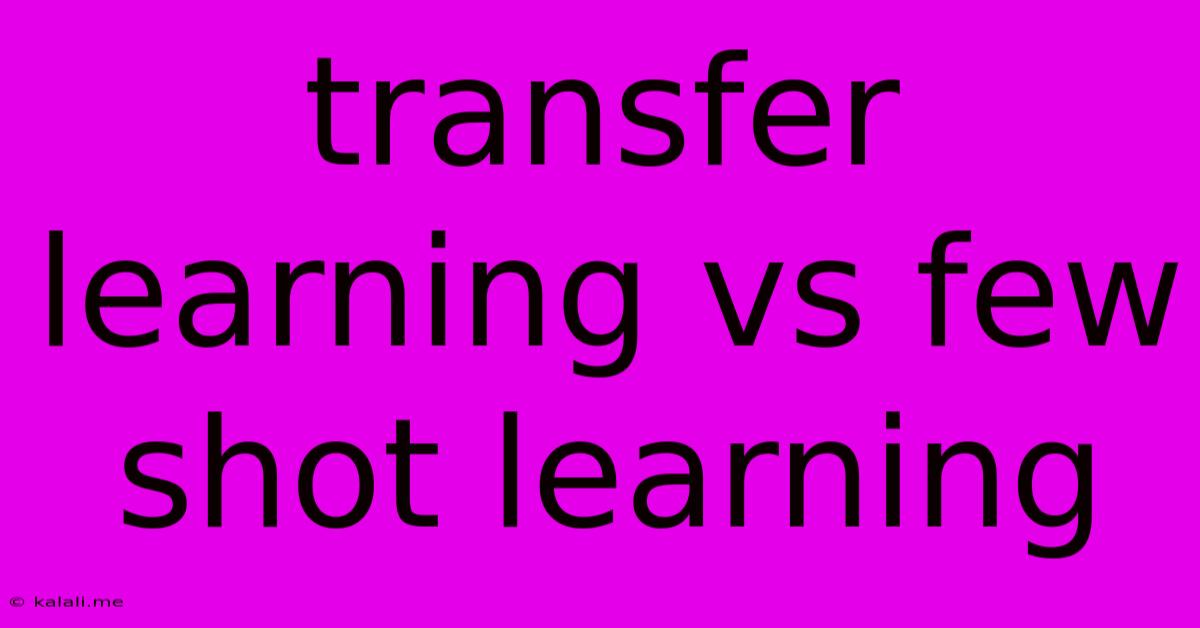Transfer Learning Vs Few Shot Learning ??
Kalali
May 26, 2025 · 4 min read

Table of Contents
Transfer Learning vs. Few-Shot Learning: Unlocking the Power of Limited Data
Transfer learning and few-shot learning are both powerful techniques in machine learning that address the challenge of training models with limited data. While they share similarities, they differ significantly in their approaches and applications. This article will delve into the nuances of each, highlighting their key distinctions and when to apply each method. Understanding these differences is crucial for choosing the optimal strategy for your machine learning project, particularly when dealing with scarce datasets.
What is Transfer Learning?
Transfer learning leverages knowledge gained from solving one problem to improve performance on a related problem. Imagine training a model to identify cats and dogs; this model learns features like fur patterns, ear shapes, and body structures. This learned knowledge can then be transferred to a new task, like identifying different breeds of cats, significantly reducing the amount of data needed for the new task. Essentially, you're utilizing a pre-trained model as a starting point, fine-tuning it on your specific dataset.
Key characteristics of Transfer Learning:
- Source and Target Domains: Transfer learning involves a source domain (the problem the model was initially trained on) and a target domain (the new problem). These domains should be related, ensuring that the learned features are transferable.
- Pre-trained Models: Leverages pre-trained models, often on massive datasets like ImageNet (for image recognition) or large language models (for natural language processing). These models provide a strong foundation.
- Fine-tuning: The pre-trained model's weights are adjusted using the target domain's data, adapting it to the specific task. This requires a moderate amount of data.
- Feature Extraction: In some cases, only the features extracted from the pre-trained model are used, and a new classifier is trained on top. This requires even less target domain data.
What is Few-Shot Learning?
Few-shot learning tackles the challenge of training models that can generalize well from very limited examples. Instead of needing thousands or millions of images, a few-shot learning model might only require a handful of examples per class to learn to identify new objects or concepts. This is particularly useful in scenarios with scarce data or high annotation costs.
Key characteristics of Few-Shot Learning:
- Meta-learning: Few-shot learning often relies on meta-learning algorithms, which learn to learn. These algorithms learn how to quickly adapt to new tasks with limited data.
- Emphasis on Generalization: The primary goal is to generalize well to unseen classes or examples based on limited training data.
- Data Augmentation: Techniques like data augmentation are often used to artificially increase the size of the limited dataset.
- Metric Learning: Many few-shot learning methods focus on learning effective distance metrics or similarity measures between data points.
Transfer Learning vs. Few-Shot Learning: A Comparison
| Feature | Transfer Learning | Few-Shot Learning |
|---|---|---|
| Data Requirement | Moderate amount of data for the target domain | Very limited data (a few examples per class) |
| Approach | Adapting a pre-trained model | Learning to learn from few examples |
| Goal | Improve performance on a related task | Generalize to unseen classes with limited data |
| Techniques | Fine-tuning, feature extraction | Meta-learning, metric learning, data augmentation |
| Typical Use Cases | Image classification, natural language processing | Robotics, personalized medicine, rare disease classification |
When to Use Which Technique?
-
Choose Transfer Learning when: You have a moderately sized dataset for your target task and a related pre-trained model is available. This is generally the more efficient approach when you have some data available.
-
Choose Few-Shot Learning when: You have extremely limited data, and obtaining more data is impractical or costly. This is best suited for tasks requiring high generalization abilities with minimal training examples.
Conclusion:
Both transfer learning and few-shot learning are invaluable tools for handling data scarcity in machine learning. The choice between them depends primarily on the amount of available data and the specific requirements of the task. Understanding their strengths and limitations is crucial for building robust and effective machine learning models. Often, a combined approach, leveraging aspects of both techniques, can yield the best results.
Latest Posts
Latest Posts
-
What Is 20 Percent Off Of 39 99
Jul 03, 2025
-
Where Is The 3 In Riddle Transfer
Jul 03, 2025
-
How Much Does A Water Bottle Weight
Jul 03, 2025
-
How Many Inches Is Half A Yard
Jul 03, 2025
-
How Old Are You If Your Born In 1996
Jul 03, 2025
Related Post
Thank you for visiting our website which covers about Transfer Learning Vs Few Shot Learning ?? . We hope the information provided has been useful to you. Feel free to contact us if you have any questions or need further assistance. See you next time and don't miss to bookmark.